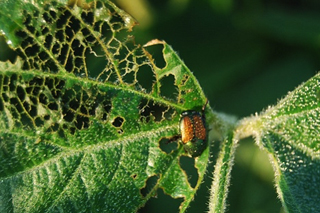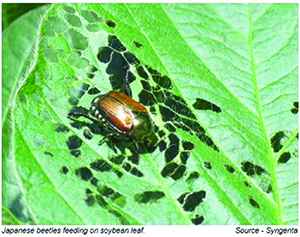Identifying And Managing Japanese Beetles
Jul 08, 2021

Life Cycle and Identification
Japanese beetles have 1 life cycle per year. Japanese beetles experience 3 growth stages – egg, larvae (grub) and adult. Japanese beetles will overwinter in the soil as 3rd instar larvae (grub).
As soil temperatures warm, larvae move closer to the surface and pupate. Adults will begin to emerge around mid-June. Female beetles begin to lay eggs in the soil in July and August. When eggs hatch, larvae will feed on roots and decaying plant material.
Larvae Stage Identification
From field crops to ornamental plants, Japanese beetles feed on over 300 plants. Beetles will feed on leaf tissue between the veins, leaving the leaves to look “skeletonized.” Japanese beetles can continue to feed on the leaves, removing more leaf tissue and reducing the total amount on leaf surface area available to collect sunlight for photosynthesis. Continued reduction of leaf tissue during grain fill may reduce yields.
Scouting Procedures
Japanese Beetle Scouting and Thresholds for Corn and Soybean
Japanese Beetle
NK Seeds
Japanese beetles have 1 life cycle per year. Japanese beetles experience 3 growth stages – egg, larvae (grub) and adult. Japanese beetles will overwinter in the soil as 3rd instar larvae (grub).
As soil temperatures warm, larvae move closer to the surface and pupate. Adults will begin to emerge around mid-June. Female beetles begin to lay eggs in the soil in July and August. When eggs hatch, larvae will feed on roots and decaying plant material.
Larvae Stage Identification
- ½” to 1” long
- Cream-colored with a brown head
- Can easily be confused with other common grubs found in the soil
- Approximately ½” long
- Shiny metallic green
- Shiny metallic bronze wings
- 6 tufts of white hair along abdomen
From field crops to ornamental plants, Japanese beetles feed on over 300 plants. Beetles will feed on leaf tissue between the veins, leaving the leaves to look “skeletonized.” Japanese beetles can continue to feed on the leaves, removing more leaf tissue and reducing the total amount on leaf surface area available to collect sunlight for photosynthesis. Continued reduction of leaf tissue during grain fill may reduce yields.
Scouting Procedures
- Japanese beetles are very mobile and tend to aggregate in different areas of the field. Because of this, we recommend scouting the entire field for damage. Doing this will provide a more accurate representation of damage levels than only scouting certain portions, which may give the appearance that infestation levels are higher than they actually are.
- Feeding damage from the beetles is generally higher along the borders because of movement into the field from other host plants
- The greatest risk of injury from Japanese beetles is during reproductive stages. You should consider treatment if there are high populations of beetles present during reproductive stages.
- Japanese Beetles have many look-alikes (including the false Japanese beetle), so be cautious with identification

Treatments
- Insecticide treatments should be made if thresholds are met to prevent yield loss
- Consider an insecticide application if defoliation is 30% before R1 and 20% after R1
- Because of their mobility, Japanese beetles may repopulate an area that was recently treated
- Retreatment may be necessary to protect leaf tissue during pod fill if beetles move back into the fields
Japanese Beetle Scouting and Thresholds for Corn and Soybean
Japanese Beetle
NK Seeds